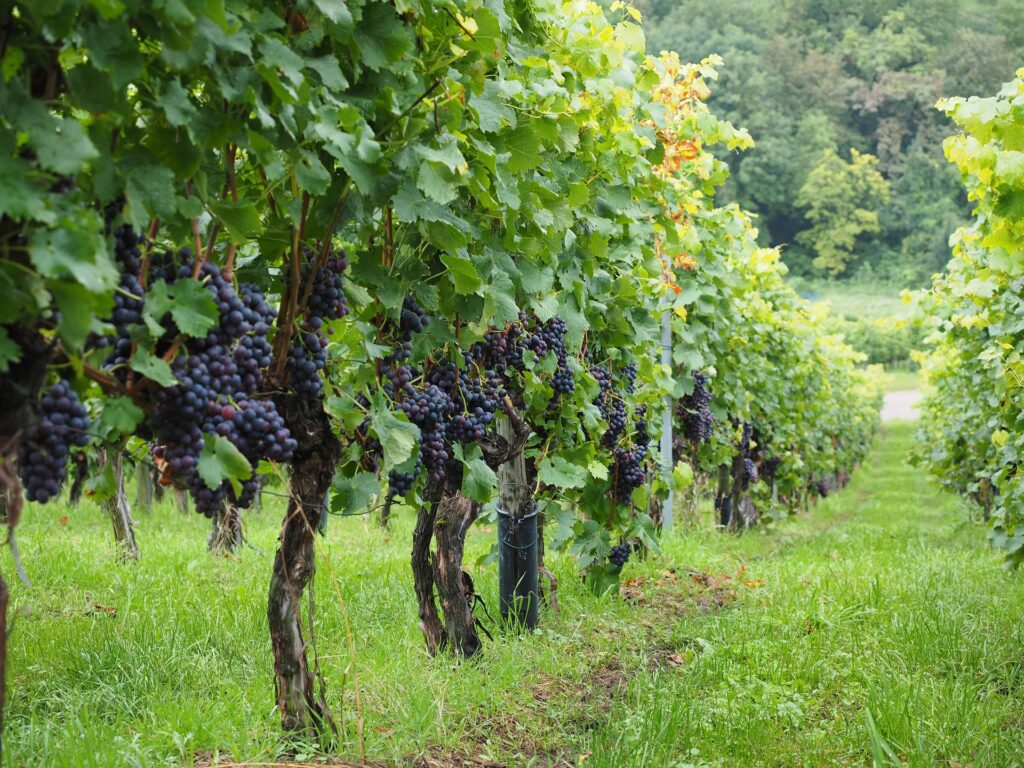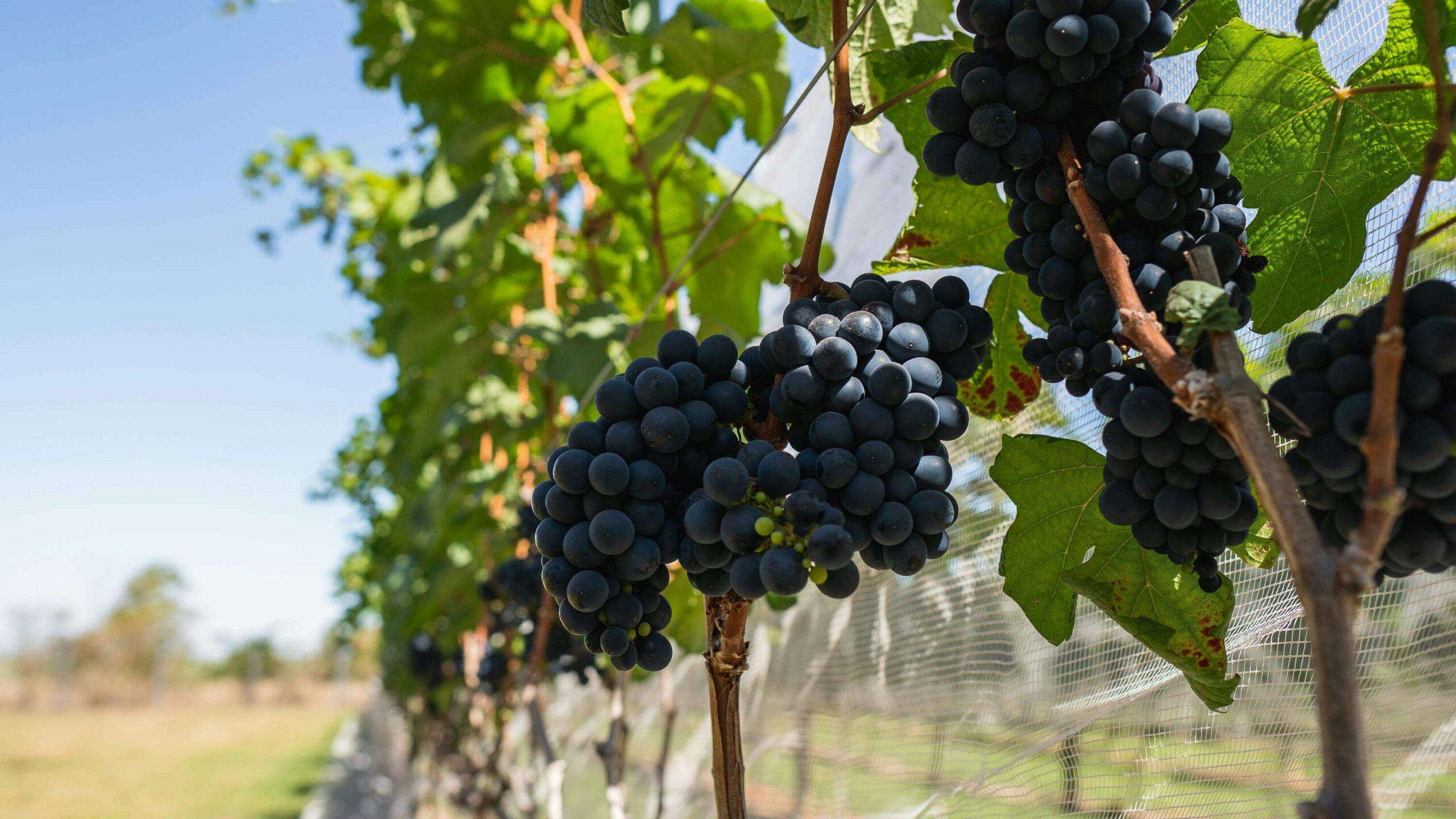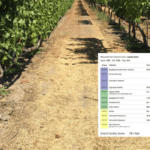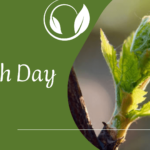Winegrowers do several different canopy management tasks in the vineyard to regulate the quality of the grapes and consequently the wine. Canopy management refers to all vineyard tasks which affect the structure of the grapevine canopy, such as pruning, leaf trimming, leaf thinning, shoot thinning, shoot positioning, cluster removal, etc. In this article we are going to take a closer look at leaf thinning, also known as leafing, leaf removal, cluster zone leaf removal, leaf pulling and defoliation. All those terms basically refer to removing of selected leaves from the area around the fruit cluster.
A number of studies have shown that a proper(!) cluster zone leaf removal can:
- improve air circulation around the cluster
- increase exposure of clusters to sunlight and allowing light penetration
- reduce potential disease pressure of grapevine disease, especially Botrytis, downy mildew, and oidium
- allows better spray penetration i.e. cluster coverage of fungicides
- improve grape quality – improve flavor compounds, color, decrease titratable acidity, pH, and reduce “vegetative” aromas in some cultivars
Effect of cluster zone leaf removal on grape composition
Cluster-zone leaf removal has been widely used in the vineyards of cool climate grape-growing regions, especially for red varieties to increase the intensity of the berry color and therefore wine. Studies have shown that dense canopy and poor sunlight exposure results in poor quality of the wine, while fruits exposed to sunlight are generally higher in total soluble solids, anthocyanins, and phenolics and lower in titratable acidity and malate compared to shaded fruit. In a study from Oregon, they found out that 100% leaf removal conducted at the pea-size berry stage improved Pinot Noir grape quality through the increase of phenolics and grape-derived volatile compounds and their precursors (terpenoids and C13-norisoprenoids). Another study from Finger Lakes and Long Island found that removing of basal leaf reduces IBMP (3-isobutyl-2-methoxypyrazine) accumulations in berries for Cabernet Franc and Merlot vine varieties. High concentrations of IBMP give wine unpleasant green “vegetative” and “earthy” aromas which are associated with under-ripeness in a cool climate. A study from Poland reveals that early defoliation (at pre-flowering) is an effective strategy for improving berry quality in cool climate areas since it led to higher concentrations of soluble solids, and lower amounts of titratable acidity in grapes. They also found, interestingly, that leaf removal in this study did not have a significant influence on berry and cluster weights or on pH.
Although leaf removal can have positive effects on quality of grapes, too thin canopy or leaf removal late in the summer and in a hot climate can increase sunburn risk and result in a poor color development of grapes. Therefore, it makes sense to start with leaf removal early after fruit set, so that the young berries can adapt to the sunlight, and more selectively depending on the climate and row orientation. In cool and sunny environments partial defoliation on cooler side is recommended, which usually means removing of leaves around the cluster in the morning sites, where there is less intensity of the heat and sun is not so strong during the day. Pay attention to the sun movement and row orientation, so in case if the sun at the beginning of fruit set is one one side of the row, and then move to the other side of the row towards the end of the veraison. Careful partial removal of leaves is recommended.

“Traditional” vs. “early” leaf removal
Traditional leaf removal refers to leaf removal at any time between fruit set and veraison, while 2-4 weeks before veraison is considered as the best time to perform the task. The intensity of the leaf removal depends on the canopy density and climate and usually varies between 40% and 100% which means removing from two to five leaves around the clusters. The intensity of the leaf removal is usually higher in red than white wine grape varieties.
While early leaf removal refers to leaf removal immediately before bloom and fruit set and it’s used to regulate yield on over-cropping varieties as a means to increase the quality of the grapes, and decreasing cluster compactness on tight-clustered varieties for controlling cluster rot disease. One study found that early leaf removal can also impact on potential vine vegetative growth (vine size, cane diameter, and main leaf area) already after the first year of treatment as compared to non-defoliated vines. Despite all those positive effects early leaf removal can also have negative consequences on yield, especially in years where the unfavorable weather has already reduced fruit set, while it’s not recommended for low-yield varieties.
Manual vs. mechanical leaf removal
Cluster leaf zone removal is very labor and time intensive work in the vineyard. In most cases is done manually which is very costly since it requires a lot of hardworking hands to the job, depending on the vines vigor, and the size of the vineyard area. In this case, mechanization can lower the price of the work, through reducing the labor costs and saving time. However, there are some limitations to the mechanical leaf removal such as vines needs to be trained in vertical shoot positioned (VSP), machinery can cause small level of damage to the post-veraison fruits, while you must know how to adjust the side roller for defoliation so it does not remove too many leaves at once. So when working with hands, you get the job done as you like, perfectly remove the amount and the desired leaves, while with the machinery, you can save a lot of time.
Conclusion
Leaf removal has several benefits, from improving grape and thus wine quality to making other vineyard activities much easier, such as enabling good cluster coverage of fungicides, to easier harvest, without all the excessive leaves around the fruits. However, what works for one vine variety in the particular growing area, may not work for yours. So keep in mind that any grapevine cluster zone leaf removal technique depends on the climate of the grape-growing region, row orientation, vine variety, training system and any winemaker’s wishes regarding the quality of the grapes. In the article, we provided some basic advice and techniques of leaf removal to consider. If you want to implement leaf removal in your vineyard, then the best way is to start on a small area and carefully monitor what’s happening with the quality of the fruits (pH, Brix, TA) and continue on the basis of your findings. You can enter your findings in eVineyard application and start improving the quality of your grapes today.
Sources:
- An Overview of Cluster-Zone Leaf Removal Strategies for Cool Climate Vineyards, by Maria Smith and Michela Centinari on PSU, Wine&Grapes, 2015
- Canopy Management – Leaf Pulling Time, by Fritz Westover on Westover vineyard advising
- Hui Feng, et.al, 2014. Influence of cluster zone leaf removal on Pinot noir grape chemical and volatile composition. Food Chemistry 173 (2015) 414–423.
- Kamila Mijowska, et.al, 2016. Impact of Cluster Zone Leaf Removal on Grapes cv. Regent Polyphenol Content by the UPLC-PDA/MS Method. MDPI, Basel, Switzerland.
- Silvia Guidoni, et.al., 2008. Manual and mechanical leaf removal in the bunch zone (Vitis Vinifera L., cv Barbera): Effects on berry composition, health, yield and wine quality, in a warm temperature area. J. Int. Sci. Vigne Vin, 2008, 42, n°1, 49-58.
- Featured image by Maurício Mascaro





